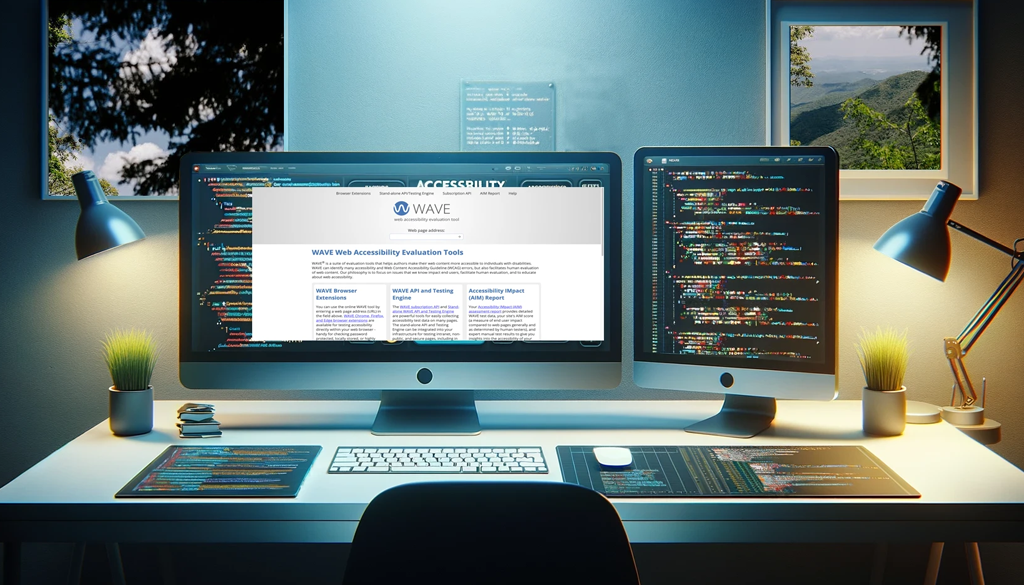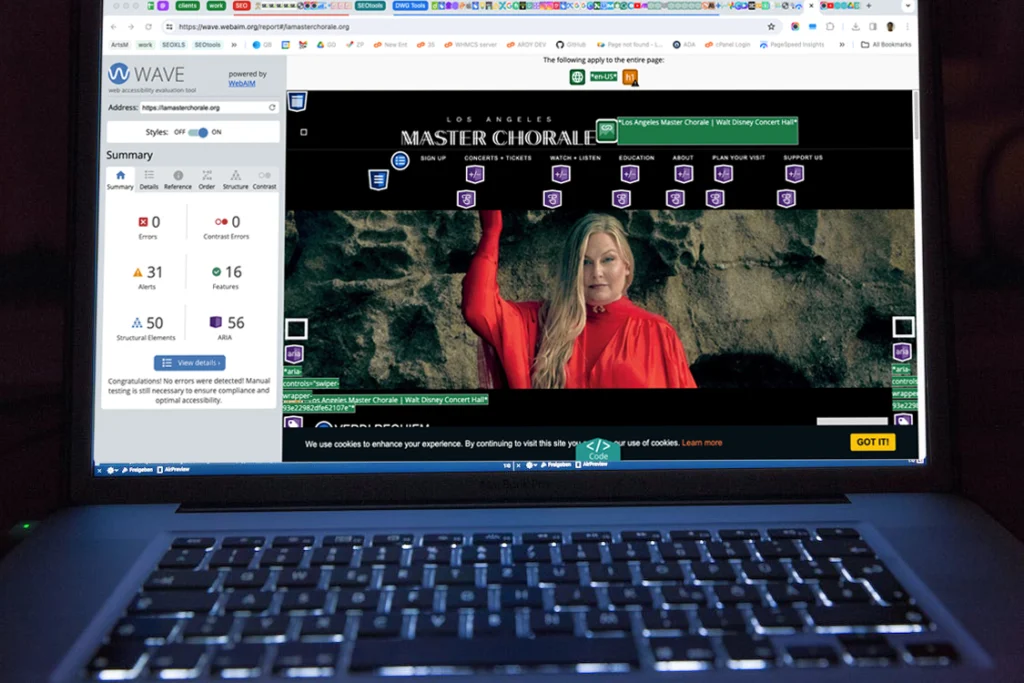Empowering Performing Arts with improved accessibility
The web presence of performing arts organizations and artists has been rapidly evolving with the addition of many new requirements. Having a solid online presence is crucial for any performing arts organization, which includes having a well-designed and accessible website that not only showcases their performances but also sells tickets and engages with their audience.
However, many organizations fail to recognize accessibility’s impact on their search engine optimization (SEO) strategies. Accessibility ensures that all individuals, regardless of their abilities, can access and navigate the website, but it also plays a significant role in improving search engine rankings.
In this article, we will explore how accessibility shapes SEO strategies for performing arts websites and why it is essential for organizations to prioritize accessibility to stay competitive in the ever-evolving digital landscape.
Accessibility and its Importance for Performing Arts Websites
Accessibility refers to designing and developing websites that allow individuals with visual, auditory, physical, or cognitive disabilities. As per the World Health Organization (WHO), around 15% of the world’s population lives with some form of disability.
But what does accessibility have to do with performing arts websites? The answer lies in the fact that an accessible website is not just beneficial for individuals with disabilities, but it also improves the overall user experience for all users. Improvements include fast loading times, easy navigation, and straightforward content, all factors that search engines consider when ranking websites.
Moreover, having an accessible website can also lead to increased website traffic, allowing a broader audience to access the content. Improved traffic can result in higher ticket sales and engagement, ultimately impacting the overall success of the performing arts organization.
The Impact of Accessibility on SEO
Search engine optimization (SEO) is optimizing a website for search engines to improve its visibility and ranking in search engine results pages (SERPs). It involves various techniques like keyword research, content optimization, and link building.
However, one overlooked factor in SEO strategies is accessibility. Google, the world’s most popular search engine, considers accessibility when ranking websites. This means that having an accessible website can give performing arts organizations a competitive advantage in search engine rankings.
Furthermore, accessibility can also improve the website’s overall user experience, which can lead to longer visit durations and lower bounce rates. These are all factors that search engines consider when determining the relevance and quality of a website.
Incorporating Accessibility into SEO Strategies
Now that we understand the importance of having an accessible website for performing arts organizations, it is essential to know how to incorporate accessibility into SEO strategies. Here are some critical steps that organizations can take:
-
- Use alt tags for images and videos to make them accessible for visually impaired individuals.
- Implement proper heading structures and use descriptive titles and headings for web pages.
- Ensure color contrast is sufficient for individuals with visual impairments.
- Provide keyboard navigation options for individuals who cannot use a mouse.
- Use descriptive anchor text for hyperlinks.
- Optimize website loading times to improve user experience for individuals with cognitive disabilities.
- Provide transcripts for audio and video content.
By implementing these steps, not only will the website be more accessible to individuals with disabilities, but it will also improve its overall search engine ranking.
How Accessibility Shapes SEO Strategies for 2024
As technology continues to advance, the importance of accessibility in SEO strategies is only going to increase. By the 4th quarter of 2024, an estimated 52% of all internet usage will be through mobile devices. The increased website traffic from mobile devices forces all designers and site owners to optimize their sites for mobile devices first. These improvements include ensuring accessibility on mobile platforms.
Moreover, with the rise of voice search and virtual assistants, websites must also be optimized for voice commands and screen readers. Optimization for voice command means incorporating features such as alt tags, headings, and transcripts, which is essential not just for individuals with disabilities but for all users.
Plus, as search engines prioritize user experience and relevance in their algorithms, having an accessible website will become even more critical for performing arts organizations looking to improve their online visibility and success.
Benefits of Prioritizing Accessibility for Performing Arts Organizations
Apart from improving search engine rankings and overall user experience, there are several other benefits to prioritizing accessibility for performing arts organizations. These include:
-
- Meeting legal requirements and avoiding potential lawsuits.
- Expanding the reach and audience of the organization.
- Showing commitment to inclusivity and diversity which can improve brand reputation and loyalty.
- Improving the overall user experience for individuals with disabilities, creating a more inclusive and welcoming environment.
- Providing equal opportunities for individuals with disabilities to engage with and enjoy the performing arts.
- Staying competitive and relevant in an ever-evolving digital landscape.
Mistakes to Avoid
While incorporating accessibility into SEO strategies is crucial for performing arts organizations, there are some common mistakes that organizations should avoid to ensure the effectiveness of their efforts.
-
- Ignoring the needs of individuals with different types of disabilities. It’s important to consider all kinds of disabilities, including visual, auditory, physical, and cognitive impairments, when optimizing for accessibility.
- Relying solely on automated accessibility tools. While these tools can be helpful, they are unreliable and may miss specific accessibility issues.
- Focusing only on compliance. Meeting legal requirements is essential, but organizations should go above and beyond minimum standards to prioritize accessibility for all users.
- Refrain from ongoing maintenance and updates. Accessibility needs may change, so reviewing and updating the website must ensure continued accessibility.
- Using inaccessible third-party plugins or tools. If using any third-party plugins or tools on the website, organizations should ensure they are also accessible to individuals with disabilities.
By avoiding these mistakes and continuously prioritizing accessibility in SEO strategies, performing arts organizations can not
Should You Prioritize Accessibility or SEO?
When it comes to whether to prioritize accessibility or SEO, the answer is simple: both.
While these two factors are competing against each other, they go hand in hand. Incorporating accessibility into SEO strategies can improve search engine rankings and enhance the overall user experience for all users.
Prioritizing one over the other can lead to missed opportunities and potential barriers for individuals with disabilities. For example, focusing solely on SEO may result in a website not being accessible for individuals who use screen readers or have visual impairments.
On the other hand, prioritizing accessibility without considering SEO may result in a website that is not optimized for search engines and, therefore, has lower visibility and reach. Prioritizing accessibility without considering SEO could ultimately hinder the accessibility efforts of the organization as it may not reach as many individuals with disabilities.
Furthermore, accessibility and SEO are essential for creating a genuinely inclusive and welcoming online presence. By prioritizing both, organizations can ensure equal opportunities for individuals with disabilities to engage and experience the performing arts while staying competitive in the digital landscape.
It is also essential to note that incorporating accessibility into SEO strategies is not a one-time task. It requires ongoing efforts and updates to ensure that the website remains accessible as technology and search engine algorithms continue to evolve.
Tips for Balancing Accessibility and SEO
To effectively balance accessibility and SEO, performing arts organizations can follow these tips:
-
- Educate yourself and your team on the importance of both accessibility and SEO.
- Incorporate accessibility considerations into the website design process from the beginning.
- Continuously review and update website accessibility features, such as alt tags and headings, to ensure they are effective.
- Regularly audit website accessibility and make necessary improvements.
- Utilize tools and resources, such as Google’s Lighthouse tool, to assess accessibility and SEO simultaneously.
- Prioritize both accessibility and SEO in website content creation.
By following these tips and prioritizing accessibility in SEO strategies, performing arts organizations can create a more inclusive and successful online presence that benefits all users.
FAQs
How does accessibility shape SEO strategies for performing arts websites in 2024?
Accessibility is crucial in the SEO landscape for performing arts websites in 2024. By ensuring that your website is accessible to all users, including those with disabilities, you can improve user engagement and increase organic traffic. Improved SEO through accessibility can include:
-
- Using relevant keywords.
- Optimizing for mobile use.
- Implement local SEO strategies to reach your target audience.
What impact does mobile optimization have on the SEO strategy of performing arts websites?
Mobile optimization plays a significant role in the SEO strategy of performing arts websites. As more users access content via mobile devices, websites not optimized for mobile can lose search rankings and miss out on potential traffic. Thus, mobile optimization is vital to staying competitive in digital marketing and reaching a broader target audience.
How can understanding user behavior enhance the SEO strategy?
Understanding user behavior can help tailor an SEO strategy to meet the needs and interests of your target audience. By analyzing how users interact with your website, you can identify which pages drive the most engagement and which keywords lead to the highest search results. You can use this information to optimize your content and boost your search rankings.
Why is local SEO important in the SEO strategy?
Local SEO is essential for performing arts websites as it helps to attract an audience from specific locations. By optimizing your website for local searches, you can increase your visibility in local search results, drive more organic traffic to your site, and ultimately, reach more of your target audience.
Conclusion
In conclusion, accessibility is a crucial factor to consider in SEO strategies for performing arts organizations. By prioritizing accessibility and implementing the necessary steps, organizations can improve their search engine rankings, reach a broader audience, and provide an inclusive user experience.
As we continue to move towards a more digitally-driven world, ensuring accessibility will be vital for the success and relevance of performing arts organizations. It is a legal requirement and a moral responsibility to create an inclusive and welcoming online presence for individuals with disabilities.
By incorporating accessibility into SEO strategies now, organizations can stay ahead of the curve and reap the many benefits it brings in the future. So, let us strive towards creating accessible and inclusive websites that truly reflect the beauty and diversity of performing arts.
Dream Warrior Group, a Los Angeles-based web design and digital marketing Company, provides solutions for your online marketing needs. Our expertise includes Search Engine Optimization (SEO), Social Media Posts and marketing, and Google PPC campaigns. Call us now at 818.610.3316 or click here.


